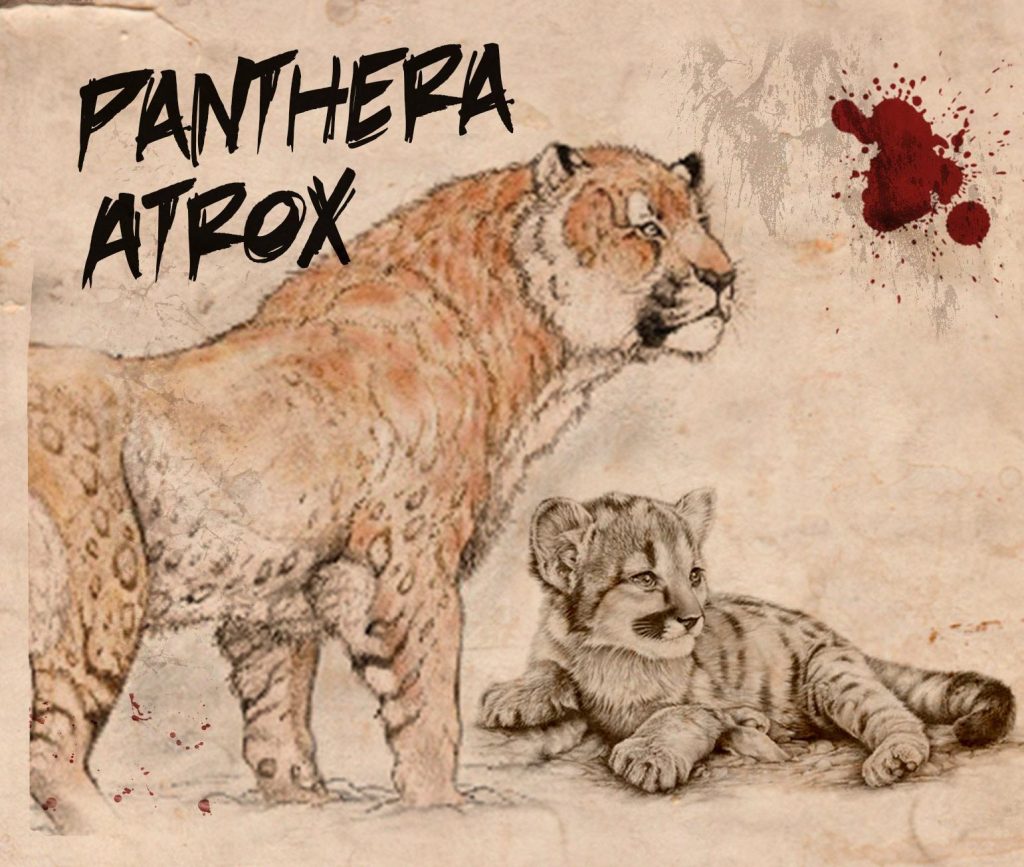When we think of lions, we usually picture the African savanna and its iconic king of beasts—Panthera leo. But did you know that North America was once home to an even larger and possibly more powerful feline? Meet Panthera atrox, commonly known as the American lion or giant lion. This magnificent predator roamed vast parts of the continent during the Ice Age and remains one of the most fascinating extinct big cats in the fossil record.
In this blog post, we’ll explore what Panthera atrox was, its evolutionary background, physical characteristics, habitat, behavior, and why it went extinct.
🧬 What is Panthera atrox?
Panthera atrox is an extinct species of large cat that lived in North America during the Pleistocene epoch, roughly 340,000 to 11,000 years ago. Its name means “cruel” or “fierce panther” in Latin—an appropriate title for one of the largest felines to ever exist.
Although it’s often called the American lion, Panthera atrox was not an exact match for the modern African lion. In fact, scientists have long debated its classification. Some researchers consider it a subspecies of the lion (Panthera leo atrox), while others suggest it might be closer to the tiger lineage or a distinct species altogether.
📏 Size and Physical Characteristics
Panthera atrox was a giant among cats.
-
🔹 Length: Up to 12 feet (3.6 meters) from nose to tail.
-
🔹 Height at shoulder: Around 4 feet (1.2 meters).
-
🔹 Weight: Estimated between 500 to 930 pounds (227 to 420 kg), with some large males potentially even heavier.
This makes Panthera atrox 25% larger than modern lions, and possibly the largest cat species in history, rivaling the Siberian tiger and Smilodon (saber-toothed cat) in size.
Its body was muscular and robust, built for strength and power rather than speed. Unlike today’s lions, there is no evidence that Panthera atrox had a mane, suggesting it may have looked more like a giant lioness or tiger.
🗺️ Habitat and Range
Fossil remains of Panthera atrox have been found across North America, from:
-
Alaska and Yukon (in the north),
-
Down to Mexico and parts of Central America,
-
And throughout the western and southern United States, including California, Texas, Florida, and Nevada.
These cats thrived in a range of habitats, including grasslands, forests, and plains, often near water sources. The most famous fossil site for Panthera atrox is the La Brea Tar Pits in Los Angeles, where dozens of individuals have been uncovered.
🐾 Diet and Hunting Behavior
As an apex predator, Panthera atrox likely preyed on large herbivores of the Pleistocene era, such as:
-
Bison
-
Horses
-
Camels
-
Young mammoths and mastodons
-
Giant ground sloths
It may have hunted alone or possibly in small family groups, though there’s little direct evidence of pack behavior like modern lions.
Given its size and strength, Panthera atrox would have been capable of bringing down very large prey, using stealth and ambush tactics. It likely competed with other powerful predators of the time, including the Smilodon fatalis (saber-toothed cat), dire wolves, and the short-faced bear.
⌛ Extinction
Panthera atrox vanished around 11,000 years ago, near the end of the Pleistocene epoch, during the Quaternary extinction event that wiped out many large mammals across North America.
Probable causes of extinction include:
-
Climate change: As the Ice Age ended, ecosystems shifted and prey populations declined.
-
Human activity: Early human hunters (Clovis people) may have hunted both the American lion and its prey.
-
Competition: With fewer resources and increasing competition, the population of Panthera atrox may have collapsed.
🔍 Fossils and Scientific Importance
Panthera atrox fossils provide crucial insights into the evolution of big cats and Ice Age megafauna. The abundance of remains at La Brea Tar Pits suggests that these animals were common and widespread.
DNA studies show that Panthera atrox was closely related to the Eurasian cave lion (Panthera spelaea) and may have descended from ancient lions that crossed the Bering Land Bridge into North America during the Pleistocene.
📚 Fun Facts About Panthera atrox
-
🦁 Panthera atrox was larger than a polar bear in some cases.
-
🧬 Genetic testing shows it diverged from the Eurasian cave lion around 340,000 years ago.
-
🏞️ It is considered part of the megafauna that dominated Ice Age landscapes.
-
🎥 It has appeared in documentaries and museum exhibits as one of Earth’s most fearsome prehistoric predators.
🧭 Final Thoughts
Panthera atrox was a true giant of its time—a silent, powerful hunter that ruled North America’s wilds during the Ice Age. Though it’s long gone, its legacy lives on through fossils, scientific study, and our fascination with prehistoric wildlife.



